M. Isidora Forrest's Blog
November 30, 2025
Isis is a Star Goddess
So, I’m still working on the funeral for Osiris (the mini-Khoiak Festival), but I’m getting there. I plan to perform the rites on winter solstice, under the dark moon.
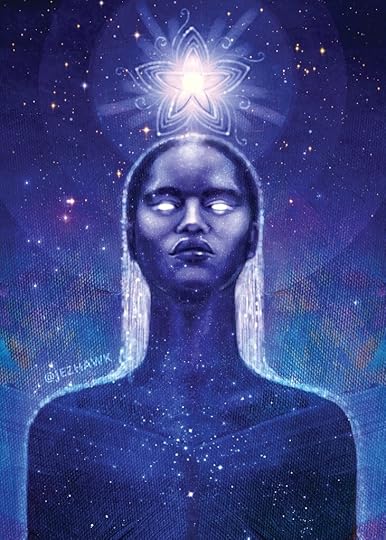 Sopdet by Jezhawk Designs. Buy your print here.
Sopdet by Jezhawk Designs. Buy your print here.Now, as we approach winter, the clear, cold nights and newly denuded branches of the trees may cause us to look up and up, into the depths of the skies.
And when we do (unless we’re in Portland, Oregon, like me), we may see the brilliance of the stars, the holy children of Great Mother Nuet, the Secret One, the Mysterious One, shining bright. Yet, even here in cloud-blessed Portland, sometimes it is a clear night and Nuet’s children sparkle oh-so-brightly. The child of Nuet Who shines most brightly to me, of course, is Isis.
And while I love Isis as a powerful Sun Goddess—the Eye of Re, and a Re-et of Re-et Goddesses—and I find Her Mysteries in the secrets and transformations of the magical moon, I am most drawn to Her, on an astronomical level, at least, as a Star Goddess.
The Star of Isis
If you’ve been reading this blog, no doubt, you already know that Her star is the star Sirius. This Latin name is the one by which She is most well known today. The Greeks called Her Sothis, which is just the Greek version of Her Egyptian name, Sopdet. She is the brightest star in the night sky and Her name means “sharp” because of the long, glittering, multi-hued and sharp-looking rays of light that extend from Her celestial being.
From at least the time of the Pyramid Texts, if not significantly before, the star Sopdet is associated with Isis. The Pyramid Texts tell us,
Your [Osiris’] sister Isis has come to You, rejoicing/aroused for love of You. You have placed Her on Your phallus and Your seed issues into Her, She being ready as Sothis, and Horus Soped has emerged from You as Horus Who is in Sothis.
—Pyramid Text 366
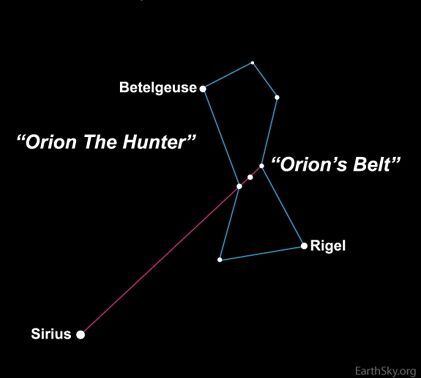 To locate Sirius, look to the left of Orion’s belt
To locate Sirius, look to the left of Orion’s beltStar Lore
Knowledge of the star was vitally important to the ancient Egyptians because the heliacal rising (just before the sun) of the Star of Isis signaled the coming of the Inundation flood that nourished Egypt’s fields, as well as the start of the Egyptian New Year.
To acknowledge Isis’ ancient connection with Her star, some shrines and temples of Isis, including the small Isis temple at Ptolemaic-era Dendera, were oriented towards Sopdet.
If your own skies are clear at night, it is easy to spot the Star of Isis in the northern hemisphere. She is to the lower left of the extremely easy-to-spot constellation of Orion, which has always looked to human beings like a human torso. The ancient Egyptians called the constellation Sah and associated it with Osiris.
Orion has been visualized as a Great Shepherd, Hunter, Warrior, or simply a Giant. And since every shepherd or hunter must have his hunting hound, Sirius itself, as well as the constellation in which it is the lead star, has been envisioned as a Great Dog. Interestingly, this is true in cultures throughout the world, from ancient Mesopotamia to China (where Sirius is a wolf) to Native North American tribes like the Blackfoot, who called it Dog-Face, and the Inuit, who called it the Moon Dog. (The Wikipedia article on Sirius seems to be pretty good and includes references.) Surely it was envisioning Orion as a shepherd, hunter, or warrior that led so many ancient peoples to see Sirius and its constellation as a companion dog.
 Sopdet, wearing the star hieroglyph as a crown
Sopdet, wearing the star hieroglyph as a crownHeliacal Rising?
Sirius cannot be seen during a period of about 70 days, from sometime in May to sometime around or after midsummer. Before this time, Sirius and the sun are in conjunction so that the sun’s greater light blocks the visibility of Sirius. The heliacal rising of Sirius is when the star and sun are sufficiently separated so that—for the first time in 70 days—Sirius can be seen on the horizon just before dawn. (See below for a calculator for when She rises in your area.)
In the northern hemisphere, this occurs in the hottest part of the year. From Classical times, this period has been known as the “Dog Days” since the Dog Star of Sirius is once again visible. This hot part of the year can be miserable indeed. Homer knew it as a time of fevers and suffering. The Romans thought it made dogs act crazy. We think of it as a time when we’re panting like a dog because of the heat.
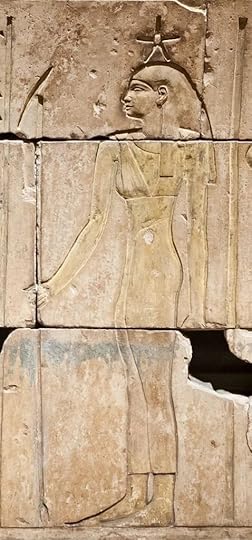
While the ancient Egyptians didn’t have the Sirius-dog connection, when Egypt came under Greek, and then Roman, rule, Isis gained Her canine-star connection. (In Egypt, She had been associated with the Canine God Anubis very early on.) In a later-period aretalogy from Kyme in modern Turkey, Isis says of Herself, “I am She that riseth in the Dog Star.”
Sopdet could also be considered the Ba—the manifestation or “soul”—of Isis. In the same way, the constellation Sah is Osiris’ Ba. In the skies, since Orion rises before Sirius, we can see the ancient myth of Isis searching for Her lost husband playing out before our eyes as the Orion constellation moves through the sky ahead of the Beautiful Star of Isis. In the “Lamentations of Isis and Nephthys,” Isis says to Osiris, “Your sacred image, Orion [Sah] in heaven, rises and sets every day; I am Sothis following after Him and I will not forsake Him.”
There is an additional interpretation of the movement of the stars through the sky that takes us to an even more important point in the Isis-Osiris story. When the Orion constellation first appears on the horizon, Osiris seems to be on his back, with Iset-Sopdet rising beneath Him. As the night passes and the constellation rises higher into the sky, He “stands up,” with Isis at His back all the while, pushing upward until the God is raised.
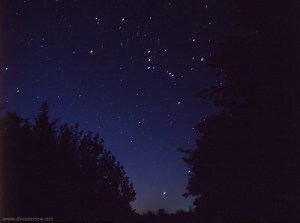 Osiris on His back (note the position of the three belt stars) with Iset-Sopdet below (at the bottom of the photo, framed by the trees), upraising Him
Osiris on His back (note the position of the three belt stars) with Iset-Sopdet below (at the bottom of the photo, framed by the trees), upraising HimEven more than the myth of Isis following Osiris to pick up the pieces, we can see Isis raising Osiris from the dead in the skies above. We can understand this as the stellar model of the ritual of Raising the Djed Column, which the pharaoh, with the help of Isis, performed on earth.
New Sirius Rising Calculator
In looking back on some of my earlier posts on this subject, I discovered that the online calculator I’ve been linking to—the one that lets you calculate when Sirius rises in your area—is no longer available.
However, thanks to KnightSpectral on r/Kemetic on reddit, I can share with you a new, free, online calculator. It’s from in-the-sky.org. Just give it a date in summer near when you think Sirius might rise in your area (try starting on July 1st, for instance), and let it use your local time. Then look down the resulting chart until you no longer see “Not observable” and instead see a date and time. That’s your local rising time and date.
I’ll share this link again in summer as we await the rising of the brilliant Star of Isis. But we have another star mystery coming January 1. And we can talk about that later.
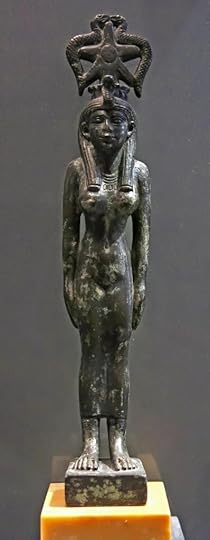 Check out the serpents around Sopdet’s starry crown
Check out the serpents around Sopdet’s starry crown
November 24, 2025
Lamentations, winter solstice & dark moon rites
I spent yesterday working on a funeral for Osiris, and totally forgot to post. Oops.
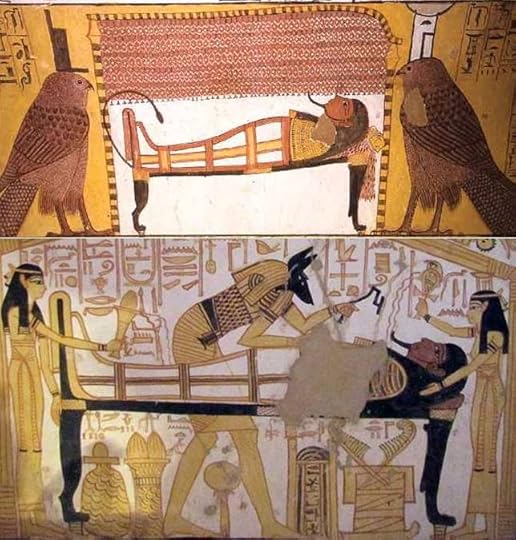 Isis & Nephthys, as kites, and in human form, lamenting Osiris
Isis & Nephthys, as kites, and in human form, lamenting OsirisThis is something She asked me to do recently. And when the Goddess says, “do the thing,” you kinda gotta do the thing.
When I checked the skies for the winter solstice, I understood why She gave me such a strong prompt. This year, the winter solstice is on December 21, but at 7:03 in the morning. December 21 is also dark moon (at barely 1%, according to my lunar app). By doing my rite on the night of the 20th (or before sunrise on the morning of the 21st), both sun and moon would be at their darkest. It seemed the right timing for a funeral for Isis’ beloved—and, of course, the following resurrection.
I don’t have the rite finished yet, but I’ll share when I do.
In the meantime, here’s some background:
Some of you may recall that the famous Roman Calendar of Philocalus (354 CE)* lists a festival called “The Isia” from October 28 through November 1.**
Much earlier, in the 1st century BCE, the Greek mathematician and astronomer Germinos noted that the Greeks believe that the Isia—which was derived from the ancient Egyptian Khoiak festival—occurs at the winter solstice. (The Khoiak festival celebrated the death of Osiris and His finding, lamentation, and resurrection by Isis.) Germinos says that that was true 120 years ago, but that, in his time, it had shifted a month earlier. The modern Kemetic Orthodox religion celebrates the Khoiak Festival in late November; so just about now.
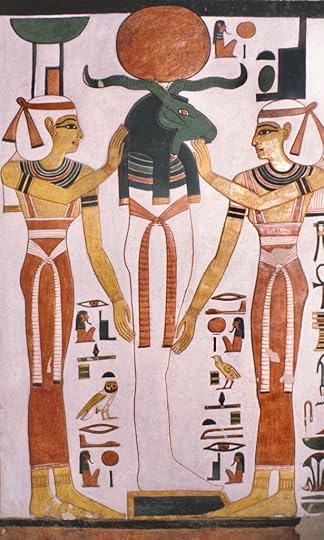 The Two Sisters work heka on Osiris
The Two Sisters work heka on OsirisHowever, here in Portland, Oregon, at the 45th parallel, we are privy to a small calendar Mystery. The ancient Khoiak Festival took place in the fourth month of Inundation, which began on the Egyptian New Year. As you know, the New Year was heralded by the heliacal rising of Sirius, the Star of Isis. The festival took place over a period of many days, culminating at the end of the fourth month with the resurrection of Osiris.
In Portland, the Star of Isis rose this year on August 22. Four 30-day Egyptian months from that date is December 21, the winter solstice. (This year, it’s 121 days; hey, the universe is organic.) What I’m working on will be a very compressed Khoiak festival, a funeral for Osiris.
I’m taking as my guide, the introduction to a text containing the “Lamentations of Isis and Nephthys.” It dates from the second century BCE and is written in hieratic. The copy we have appears to have been part of a funeral rite and is shorter than the “Songs of Isis and Nephthys,” which are also laments, but significantly longer. I’ve adapted the Lamentations text a bit for what I want to do. You’ll find the texts here, if you’d like to use or adapt them for your own work.
For my mini-Khoiak festival, there will be lamentations, offerings, glorifying, a Mystery, and resurrection—under the Wings of Isis, the Beloved Sister, and Nephthys, the Beautiful Sister.
Magically, I hope it will help add to the energy of the return of the Light, which so many of us will be engaging in at this time of year.
*The reason Philocalus’ calendar is so famous, is that it contains the oldest reference to a regular celebration of the birth of the Christos. The calendar notes: “Eighth day before the kalends of January, Birth of Christ in Bethlehem of Judea.” Earlier, one of the Church fathers, Cyprian (200-258CE), commented how very, very providential it was the when the sun was born, so was Christ.
**If we go by Philocalus, that late October-early November date for the Isia, with its emphasis on death, lamentation, and renewal, makes a perfect option for our own Samhaim/Halloween celebrations.
November 16, 2025
Offering to Isis, Available Now

I know a lot of you have been waiting a Very. Long. Time. for the new edition of Offering to Isis. (And yes, Isis Magic is coming, too. This spring!)
I’m thrilled that Offering to Isis is here now. I’m pretty sure this will be the definitive edition. It’s from Azoth Press and you can only get it at the Miskatonic Books website. Here’s the direct link.
Offering to Isis is in a beautiful faience green hardback cover. And here’s something that was pointed out to me recently by a friend: because it has a stitched fabric binding, it will lay flat when you open it. And that means you don’t have to weigh down one side of the book as you use the rituals or read the offerings. It will lay flat on your altar as you make your own offerings to Isis. So, it’s both beautiful AND practical.
It would be a lovely gift for any Isians you know, or a perfect addition to your own magical library.
While I know a lot of you are familiar with Isis Magic, maybe you haven’t yet come across Offering to Isis.
If that’s the case, I’d like to share with you a little bit about it.
I may be partial, but I really like this book. As as one reviewer said of the first edition, it isn’t just a rehash of Isis Magic. Offering to Isis is its own thing.
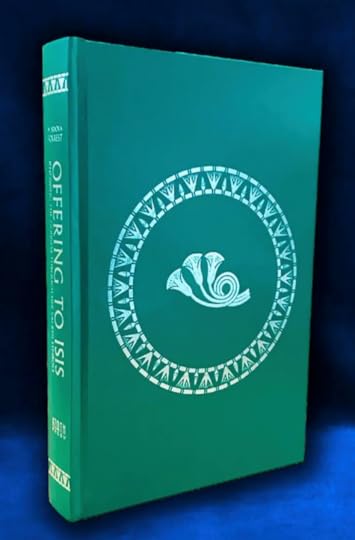
Offering to Isis is about how we can honor Isis, connecting with Her, and growing our relationship with Her, through the ancient and eternal practice of making offering. Offering is one of the most important ways we human beings have always communicated with our Deities. It was vitally important in ancient Egypt and it’s just as important for those of us devoted to or interested in Isis today.
If you’ve ever wondered exactly what sort of things to offer to the Goddess, Offering to Isis includes in-depth explanations of 72 sacred symbols associated with Isis—symbols that make ideal offerings to Her.
We’ll also talk about the how and why of Egyptian offering practices, including the important, and genuinely ancient Egyptian, technique of “Invocation Offering.”
There’s information on how the ka energy inherent in every offering is given to and received by Isis—and what to do with offerings once they’ve been received. You’ll also find a selection of offering rituals, from simple to complex, for a variety of purposes. The majority of rites are for solitary devotees, so I think you’ll find one that works just right for you.
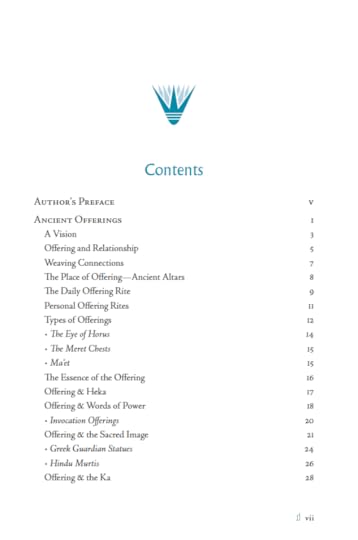 Download a complete copy of the Table of Contents here.
Download a complete copy of the Table of Contents here.If you’re curious and want to know exactly what’s in the book, you can download a PDF copy of the full Table of Contents by clicking on the caption under the “Contents” image.
The largest section of the book details the 72 sacred symbols of Isis. You’ll add to your knowledge of Isis and Her ancient worship by learning more about Her through Her important sacred symbols. You’ll see how each one is intimately connected with Her and how they may be used in offering rites for Her. Every entry also includes an Invocation Offering that you can use for your own offerings to Isis.
One of the things I especially like about this book is that you can just open it at random and you’ll likely find something you hadn’t known about Her, something that I hope will inspire you in your own devotions. How did the Knot of Isis come to be Her knot? What stones are associated with Her? What animals are connected with Her? Why are dreams especially important when it comes to Isis?
As it’s been a few years since this book was first published, the text has been thoroughly updated. All the hieroglyphs associated with the offerings have been re-illustrated and are much more accurate—and much more beautiful—in this new edition, too. There’s also a handy appendix in the back for quick reference in finding any offering you may need.
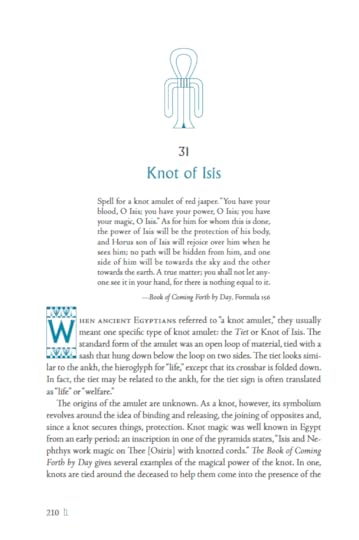 This is what a typical page looks like.
This is what a typical page looks like.This new Azoth Press edition can be purchased only through the Miskatonic Books website. (If you go to Amazon, you will be ordering a 20-year-old paperback edition published by Llewellyn in 2005, which people are trying to sell at very inflated prices.)
The new hardback edition is priced a lot lower than the overpriced, out-of-print first editions that I’ve seen out there. (And if you’d like, you can take advantage of Miskatonic’s installment plan that lets you pay over several months so it doesn’t take a big bite out of your budget.)
When you go to the Miskatonic site, you’ll find two different Azoth Press Offering to Isis editions. For the high rollers, there will be 36 copies in a gorgeous leather-bound and numbered collector’s edition. You can see that edition here. For the rest of us, there are 650 numbered, limited edition copies in a cloth-bound hardcover. Both editions are two-color throughout, and more than 400 pages. (But there are only 650 of them.)
Thank you so much for letting me interrupt our regularly scheduled blog posts to tell you about this new edition.
And would you please do me a favor and share this information with anyone who you think might be interested? Feel free to ask me any questions about Offering to Isis that you’d like.
You might think it’s a little strange, but even though I wrote the book, I still use it for reference when I’m making my own offerings to Isis. I use both the information in it, and the Invocation Offerings.
I hope this new edition will serve you well, too.
November 9, 2025
Your First Steps with Isis
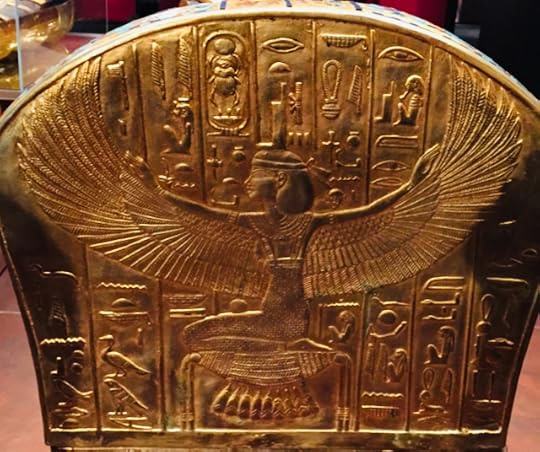
Many of you who subscribe to this blog are well beyond your first steps with Isis. If that’s you, I do hope you’ll share your stories in the comments or on social media.
But some of you who ended up here may have stumbled upon this blog while searching for information about Goddess Isis. Perhaps you’re simply curious about Isis and want to find out “what’s out there” about Her. Maybe you’ve always been drawn to ancient Egypt. Or maybe you are looking to take your first steps towards Her—and wondering how to do so.
Maybe you’ve had a dream. (Yes, She often calls to us through dream.) Perhaps you have repeatedly come across Her name or Her images. Repeatedly. Perhaps you had an oracle or a tarot reading that guided you to Her. Perhaps you simply had a feeling that left you wondering, “is that Isis?”
On the other hand, it might be something more dramatic, like a powerful experience at a festival or in circle or in your private meditations, an experience that leaves you in no doubt that SOMETHING has occurred. (Here’s an example from my own early days of forming my relationship with Her. I heard Her speak my name, loudly and emphatically—and just once. It sounded as though I had heard it with my physical ears, not my metaphysical ones. I whipped my head around so fast looking for who/Who had called my name. And in fact, so powerful was this calling that I still vividly, vividly remember it many years later.)

So, what to do? First, know that you don’t have to do anything. You can totally ignore these promptings. If now is not the right time for you to take on this connection, you don’t have to. But I would gently and kindly suggest that you be gentle and kind, too, and tell Her, “no, thank You.” If this is something you just don’t want, ever, that’s okay. But if your response is, “not now, maybe later,” let Her know that, too.
In most cases, Isis will take no for an answer. If your dreams or other promptings continue after your refusal, then there may be something She feels you need to know or take care of, even if it’s not a relationship with Her. How you handle this depends on your own specific circumstances.
But let’s say you do want to enter into a relationship with Isis. Now what?
There are some things you can do right away. First, read, read, read. Since you’re here, read back over older Isiopolis posts. In the sidebar, check out the archives. There’s a lot of information here about Isis, things that will help guide your understanding of Her nature. Sometimes, I’ve even written of my own experiences with Her. That will help give you an idea of what interactions with Her might be like. (Yes, of course, your interactions will be distinctly yours, but it does help to know what others have experienced.)
Reading everything from the experiences of modern devotees to the research of scholars is valuable in learning how your experiences match up with those of others, now and throughout the history of Her worship.
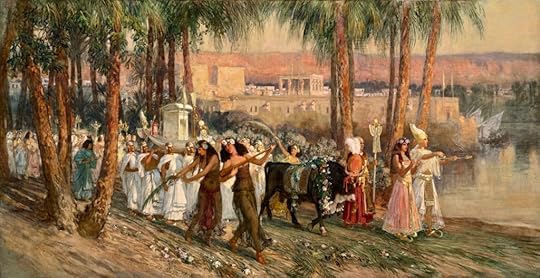
In addition to reading, see if you can find a space that can serve as a focus for your interactions with Her. In many cases, this will be an altar space. This can be as simple or elaborate as you like and as you have the ability to create. Choose a corner of your room or a small table that you can devote for this purpose. If you don’t have space like that, or if you’re a young person living at home and your parents might object, something as simple as a picture of Her on your wall or above your bed will suffice. Just make it somewhere you can sit in front of (so you can see it) or near during your meditations.
Once you have made the decision to explore a relationship with Isis and have some kind of a focus for your devotions, I would suggest making a formal vow to express your dedication to this exploration. Don’t make it a forever-vow. Make it for six weeks, or six months, or a year. At the end of the time you’ve chosen, you can re-access and decide whether you wish to continue beyond that time.
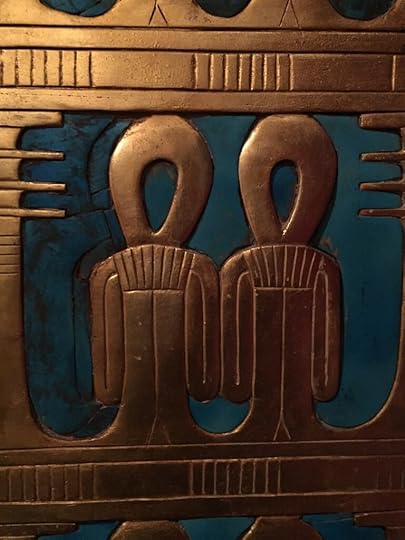
Making Your Dedication
Your dedication can be something as simple as lighting candles at your altar and speaking your intention or something as elaborate as the ritual of “Tying the Knot of Isis” from Isis Magic. On the simpler side, here are some words you can use or adapt in making your vow:
Words of Power of the Votary of Isis:
Hear me, Isis, and take my hand. Make fast the Knot that unites me with Thee. Grace me, Goddess, with Thy presence. I ask Thee with the breath of my body; I ask Thee with the thoughts of my mind; I ask Thee with the beat of my heart—to hear me. And open to me as I open to Thee. I speak Thy name, Isis. I drink in Thy love. I am for Thee, Goddess. I am Thy votary* for the period of <naming the time period you have chosen>. Accept these words of power, Isis, and all things beautiful and pure. Amma, Iset [AH-mah, Ee-set].
Isis Magic, 2nd edition (new edition out next March)
Following your dedication, your threefold work begins: the development of openness to Isis, the unfolding of hope, and the practice of expectation.
Developing Openness to Goddess
Being open to Isis is a subtle thing. It involves openness both of mind and of the subtle body often known as the “aura,” the subtle energy field that surrounds each human being and all manifested things. (Ancient Egyptians might have called this your ka.) Openness of mind does not mean we need to give up skepticism. Indeed, we should not. We only need to be able to suspend its judgment while doing meditations and other exercises that put us in touch with the Goddess. Analyze later. Experience now. To do this, try to be present in each moment and be open to the very real possibility that Isis is indeed with you.
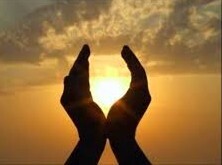
In addition to opening our minds to the possibility of the presence of the Goddess, as new votaries, we work to cultivate openness of our energy to Isis. Opening ourselves to Her is, in part, a physical openness. You can use the Opening of the Ways ritual to safely and gently open your aura to Isis, a process that will help you feel Her near you, within you, around you.
These two types of openness—of mind and aura—encourages a third: openness of spirit. Spiritual openness feels like hope; thus it is said that part of the work of the votary is the unfoldment of the wings of hope. Hope opens us to greater possibilities. Hope is a buoyant desire, a longing that can enlarge the spirit. During this early part of your exploration with Isis, you are urged to encourage hope in yourself…and in others.
Practicing Expectation
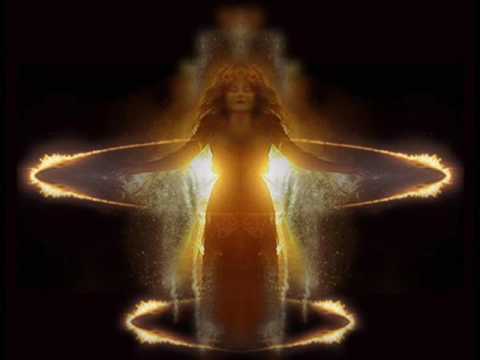
First, hope for and then, expect Isis’ presence. Like hope, the practice of expectation is a spiritual openness to possibility. Teach yourself to expect the touch and presence of Goddess. Isis is with us. Both in ancient times and today, many have felt Her presence. Many know Her reality. So can you. There is every reason to expect that Isis will make Herself known to you as you open yourself to Her. Being open and hopeful and expectant, you will see signs and portents everywhere. Does a breeze rustle the leaves of a tree as you pass, thinking of Her? It is Her breath. Have you found a piece of jewelry engraved with Her image? She confirms your Path. Did that hawk circle above you as you drive your car down a country road with Her name on your lips? She is guiding you.
It is not foolish to see such signs at every turn. Rather, it is Foolish. Like the Sacred Fool of the Tarot, we are stepping off the cliff, looking upward to Isis, trusting—hoping and expecting—that She will guide our steps. And we shall find, I promise you, that indeed She does. This trust in the Goddess brings a unique and blessed state of freedom that you will discover for yourself as you develop your relationship with Isis, taking those first steps with Her.
If you’ve already taken first steps (or more), what was your experience like?
*A votary is simply one devoted to something, in this case devoted to Isis for a specific period of time. This does not preclude any other devotions you may be undertaking with other Deities. Isis does not require exclusivity.
November 2, 2025
Isis and…Halloween?

We gazed at the waxing light of the moon last night. Its cool, pale light was beautiful, and yet sad.
That’s often how this time of year feels. Beautiful. And sad. For at this time of year, many of us remember our Beloved and Honored Dead.
 My favorite Osiris rising
My favorite Osiris risingSome of us might celebrate the solemn rites of Samhain—from a quite different culture than that of ancient Egypt. In Mexico, last night and today, they are celebrating the Day of the Dead.
Of course you’re quite right that the ancient Egyptians did not specifically celebrate either Samhain of the Day of the Dead.
Yet we know they honored their dead. And we know they did have festivals, such as the Beautiful Festival of the Valley, to celebrate with their dearly departed. Indeed, their dead could be very, very present for them, as transfigured spirits, akhu, who could help them in their day-to-day lives—or cause them trouble.
But for Isis devotees seeking a more Egyptian way to mark this time of year, I’d like to introduce you to the Isia.
A festival called the Isia is found in a calendar from 354 CE that was commissioned by a wealthy Roman Christian named Valentinus from a prominent, also-Christian scribe named Philocalus. The Calendar of Philocalus is famous because it contains the first known reference to the Christian holiday of Christmas as an annual festival of the birth of the Christ on December 25th. (There are earlier references to that date, but not as an annual festival.)
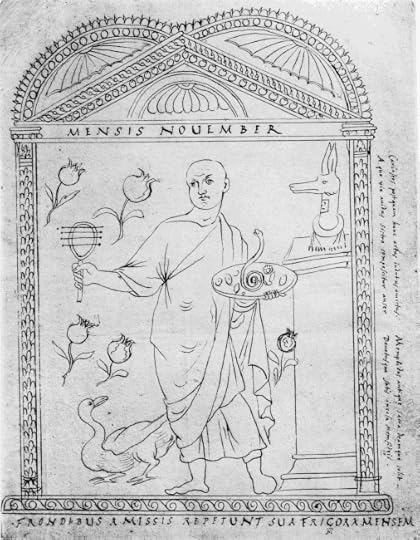 An illustration of November from Philocalus’ 354 CE calendar; note the sistrum and Anubis head
An illustration of November from Philocalus’ 354 CE calendar; note the sistrum and Anubis headBut for Isiacs, the calendar is important for its inclusion of a different festival: the Isia. Philocalus records the dates of the Isia as October 28th-November 1st. Some scholars also include the days until November 3rd as part of the Isia. That’s because Philocalus’ calendar has what was known as an “Egyptian Day” on November 2nd and a Hilaria on November 3rd, both of which may have been included in the Isia.
Let me explain: to the Romans, an “Egyptian Day” was a bad luck day. There were three in January and two in every other month. The first Egyptian Day in November fell right after the Isia, on November 2nd. These days were inappropriate for public festivals, sacrifices, and were generally stay-in-your-house-and-do-nothing days. The bad luck of the Egyptian Days continued on into medieval Christian calendars.
Why were they called “Egyptian” days? No one knows for certain. However, Egyptian calendars (for example, the famous New Kingdom Cairo Calendar) often list festivals along with auspicious and inauspicious days. So it may well be that Romans simply picked up these genuinely Egyptian bad luck days and put them into their own calendar. (This tells you how influential the worship of The Egyptian Gods—mostly Isis and Sarapis—were.) Later on, the name was taken to refer to the ten biblical plagues of Egypt to better harmonize these pagan-y days with scripture.
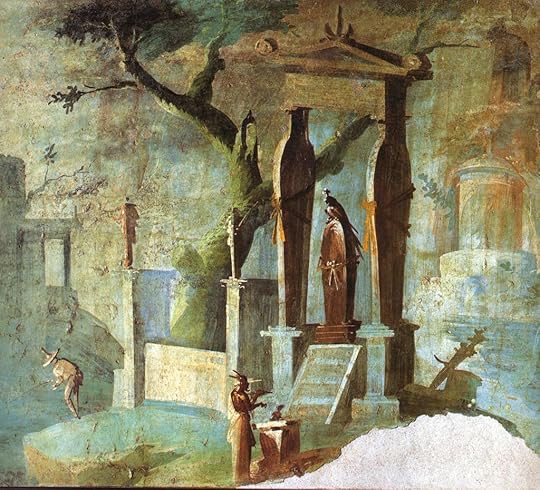 From Pompeii: Making offering before the sarcophagus of Osiris
From Pompeii: Making offering before the sarcophagus of OsirisAs for the Hilaria, there are two shown on Philocalus’ calendar, one on March 25th, at the end of a lengthy festival of Magna Mater/Kybele in which the death of Attis is mourned. The preceding day (the 24th) was the Day of Blood, on which flagellation and self-castration might take place, and it was also an Egyptian Day. The Hilaria was what it sounds like: a day of joy. People played games and feasted. Some scholars think that the spring Hilaria could be the origin of our April Fool’s Day.
So clearly, it was not absolutely unheard of to have a festival on an Egyptian Day…of course in the case of the Kybele festival, it was the (yikes!) Day of Blood. There is nothing else listed in Philocalus’ calendar for the Egyptian Day following the Isia. The November Hilaria is shown as the day after that, on the 3rd.
Yet in both cases, we have a Great Goddess with a partner to be mourned, followed by a Day of Joy. This makes very good sense from a psychological standpoint; we need relief after mourning. So it may be that we should include the Egyptian Day and the Hilaria following the Isia as part of the Isia festival after all. Which would mean that (here in the northern hemisphere) we’re approaching the festival right now. So there’s time to prepare should you choose to celebrate your own Isia.

Artist’s depiction of ceremonies at the Temple of Isis, Pompeii. Click to see it larger.
We know little else about the Roman Isia. On one hand, this frees us to create our own Isia. Given the time of year, we might choose to connect the Isia with the modern festival of Halloween. Isis is, after all, a Goddess of the Dead par excellence. There is much we could do with an Isia in which we remembered our own Honored Dead, for example by speaking their names and making offering in the ancient Egyptian tradition.
On the other hand, there is an appropriate Egyptian option for the celebration of the Isia and—and given the timing and the resonant subject matter—it is a likely candidate for the basis of the Roman Isia.
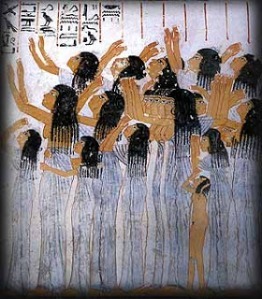 Mourning for Osiris
Mourning for OsirisThough perhaps it should more rightly be called the Osiria. For at about this same time of year, in the Egyptian month of Khoiak, the ancients held a festival for Osiris that remembered His conflict with His brother Set, His death, and His resurrection through the holy magic of Isis. We know of this festival from the period of the Middle Kingdom and have a decent record of it from the great Osirian sanctuary of Abydos. We also know of it from the Osiris chapel in Hathor’s Ptolemaic sanctuary at Denderah.
The festival re-enacted the central Isis-Osiris myth (I won’t recount it here; you all know the story.) The Egyptians molded images of Osiris from Nile mud, special spices, talismanic stones, and seeds. The images were watered so that the grain sprouted, a fitting symbol of new life. (We should also know that this was about the time of year when the Nile flood was receding so that the fields could be planted with new crops.) The festival ended with the raising of the Djed pillar, symbol of the resurrection of the God Himself as Lord of the Otherworld.
If you are so inclined, now is a perfect time to re-enact that core Isiac myth—if on a smaller and more personal scale. And should you do so from Isis’ point of view, it would be a true Isia, indeed.
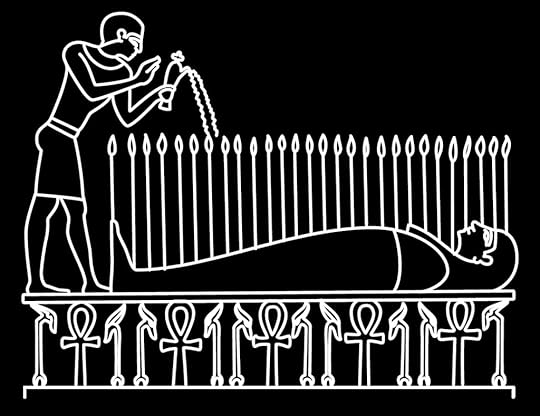 Watering the grain in the sacred image of Osiris
Watering the grain in the sacred image of OsirisI have done my own private Isia like this: I shuffle and deal out 14 Tarot cards, representing the 14 parts of the body of Osiris. I place or “hide” the cards in a circle around my temple. Then, during the several days of the festival, I ritually circle the temple, “finding” some of the cards until I have “found” them all. Then I assemble them into a roughly human-shaped, stick-figure Osiris. (This is a fairly large spread, so I place it in the middle of the floor of my temple.) On the last day of the festival, I turn over the cards, revealing them, and read them as an omen for the coming season and coming year. Naturally—to expand the rite and get myself in the proper magical frame of time, I use temple openings and closings of my choice from Isis Magic. (The Opening of the Ways works quite well; if you haven’t got your own copy of Isis Magic, you’ll find the ritual here.)
Should you decide to honor the Isia this year—in this way or some other—I would love to know about your experience. Whether you choose to connect your Isia with the ancient Khoiak festivals of Isis and Osiris, create a Day-of-the-Dead-type Isia, or celebrate some other way entirely, I wish you much depth and beauty in this darkening season of sad, sweet remembrance. May She embrace you always.
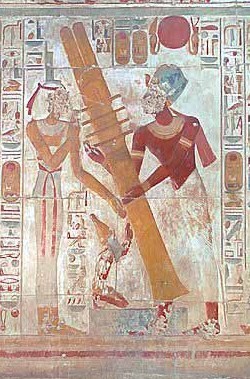
Isis and the pharaoh raise the Djed pillar, the symbol of the resurrection of Osiris
October 26, 2025
The Aretalogy of Isis from Andros
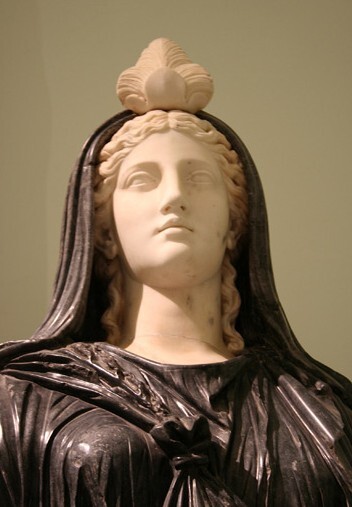 A Roman image of Isis
A Roman image of IsisToday, I’m delighted to share with you an English translation of the Isis aretalogy from the island of Andros, Greece. The island is in the Cyclades and the aretalogy was found in its capital city, Palaiopolis. Being a coastal city, it was well positioned for trade, both in goods and ideas, such as the reception of non-Greek Deities like Isis.
The English translation is the work of Pentamegistus, an esoteric blog, and is translated from Isis scholar Laurent Bricault’s French translation of the aretalogy. So it’s a translation of a translation. Here’s the link to Pentamegistus’ original post. The original aretalogy is in Greek.
The text is fragmentary in many spots, which is where you see the “…”s below. I’ve taken out the line numbers since they’re not needed for our purposes. (If you’d like to see the line numbers, in order to refer to specific lines in the text, for instance, please see the original post.) I’ve also capitalized Isis’ and other Deities’ pronouns and made some hopefully-clarifying comments inline, in brackets and blue. As you’ll see, with so many lacunae, it can get pretty difficult to make sense out of some of it.
But, we’ll see what we can do.

The Aretalogy of Isis from Andros, Greece
with a little bit of commentary
Queen of Egypt, linen-robed, filled with care for the ancient land, which the deep furrow makes abundant with wheat. Sistrum-bearing Bubastis and Memphis [likely, the Egyptian cities most connected with Isis in Greek minds] rejoicing in its fruitful fields. There, a sacred law, the work of pious kings, erected an immovable stele [a reference to the stele that the Kyme aretalogy says was set up at the Temple of Ptah in Memphis, and which may have the original Isis aretalogy inscribed upon it; some researchers suggest that by circulating copies (or riffs on the text, in some cases) of these aretalogies throughout the Hellenistic world, Isis devotees gained a sense of group connection and community], a supreme emblem of Thy kingship [that is, Isis’ rulership of the land of Egypt].
 Head of Isis-Fortuna
Head of Isis-FortunaThe suppliant crowds She addresses thus:
“I am Isis of the golden throne, whose scepter is strong, the fiery solar ray having shone upon the nourishing land [Isis is acknowledged as a Sun Goddess and She is an Eye of Re; Apollo was a major Deity on Andros and so the solar connection may have been especially important to its people].
From wise Hermes [Thoth], I learned the secret letters, and I polished them with a stylus, wherewith I engraved them for Mine initiates, the sacred, fearful words [the idea here is that the Mystery words fill the initiates with sacred fear or awe]. What the people established for their public use, all this I scrupulously wove into the depths of My mind. [I think the Goddess is saying that She approves of Her Mysteries as celebrated by the people of Andros; I love that they are “woven into the depths” of Her mind.]
I am Isis, eldest daughter of king Kronos [Geb], most honored consort of Osiris of mighty power, with whom I formerly [was?] delivered [from?] the same womb that begat us. [Perhaps referring to Isis and Osiris as Divine Siblings within Their mother Nuet’s womb.] Isis, whose hair, braided as the vine’s tendrils, is bedecked with magnificent flowers; Isis, whom the wise counsel of a king with thoughts sublime and yet a child, dreaded [by] Ouranos, helped provide mortals with laws that no foolish thought shall destroy, and time, however long, shall not dim. Never shall the fathomless and endless eternity cast them into oblivion. [Honestly, this bit with the king, feared by the primordial Greek Sky God Ouranos, and with lofty, yet childish, thoughts, is unclear. Perhaps it is saying that Isis and the pharaoh (or some local king?) worked together to create the laws.]
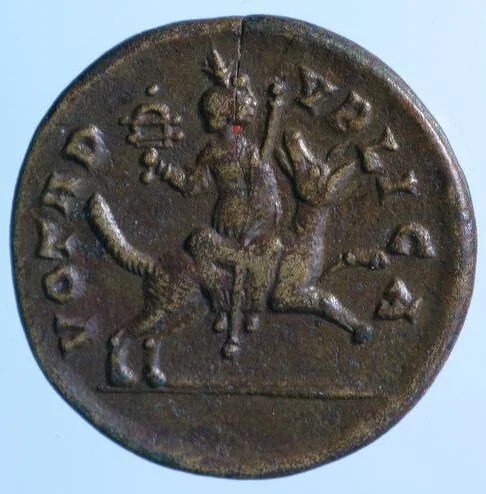 Isis, with sistrum and staff, riding a dog
Isis, with sistrum and staff, riding a dogI shimmer along the course of the starry circles wherein I move in the Canis [the star of Isis, Sirius, is in the constellation Canis Major; hence it is the “Dog Star”] constellation.
Women call me Goddess, healer of all ills. I toiled and labored to erect my dwelling in Bubastis. I, Isis, in my great wisdom, set the limits of Olympus and the humid land with dark raiment; I am She who likewise, to distinguish the seasons, delineated a winding way through the air amidst the heavenly bodies on high. Toward the celestial pole, I directed the lunar sphere, the angled bearer of the sun’s glow by its rays as well as Helios, the resplendent driver of fiery steeds, so that through harmonious courses, their axes may distinguish night from day with a dizzying, resounding movement.
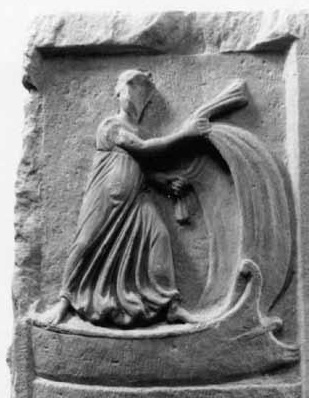 Isis Pelagia, often portrayed as striding with this wide, seafaring stance
Isis Pelagia, often portrayed as striding with this wide, seafaring stanceI am She Who first granted to men the capacity of traversing the ocean [around the seaports of the Mediterranean, Isis Pelagia, the protector at sea, was an important aspect of the Goddess]; Who fortified justice; Who at the dawn of the human race, united woman with man [other aretalogies also credit Isis with bringing together woman and man], and joyously directed newborn after newborn to the tenth lunar phase, perfect radiance of a flourishing work; She who educated the little ones who, still in the bosom, fear their parents’ punishment.
Aided by frenzied fury, I threatened with my wrath the wretched who know not love, (driving them) to howling Hades’ realm, and the black veil of the abysmal prison. I rule over a bread-producing land, for I abhor foods made by men’s destructive hands. Cave bears were frightened by it, the howling wolf, whose hunger empowers it, refusing to acknowledge it, repelled it, while in its quest for prey (?), who amidst its daily campaigns, wild, in the valley (?), which the pitiless thicket fed…spared ….in the mountains ….ignorant. …vain vigour… …they celebrate… ….his mother who devours her… …all those whose heart is roused by foolish pride… …vain…dried up… …to men, when I imposed a yoke on the…. ….the saviour… … joy for his/her mother… I Isis…still barren… …I enlarged the furrow … cut the harvest with a scythe while causing the vine to spread… the pleasant…of the days’ work… the sister’s fertile works… protectress of the suppliants long of hair… the oak still flourishing… I, Isis for the citizens… [As you can see here, this section is quite hard to make coherent sense of, given what remains of this text. It looks like the aretalogist is naming, and thus calling upon, the more wrathful aspects of the Goddess, by which She enforces Her will. The second half of this section praises Isis’ agricultural powers. But I am dying to know which “sister’s fertile works” this refers to. And I also love that She is the protectress of “suppliants long of hair,” perhaps meaning women—for Isis is always a Goddess of Women.]

…I taught the way of placating Gods by means of statues, when formerly what was contrived by an insidious fable was celebrated by poets’ chants. My people erected temples to the (…) [This likely refers to the tradition, recorded in Plutarch, that Isis and Osiris brought civilization to humanity, including the proper ways to worship Deities, prior to which humans only had “insidious fables.” This surely also connects with the later Hermetic tradition of how to correctly enliven a Divine image. And we know Greeks were inspired by Egyptian temple construction.] I unloosed the tyrants’ cruel chains. Enyô [a Greek War Goddess, sometimes the consort of Ares], bespattered in the blood of slaughter, when I showered Her with the cursed waters at the marshes of Styx, with My wrath I expelled Her from the realm of Hades into Tartaros [the Underworld], wherein the punishments decreed the death of My terrible prey.
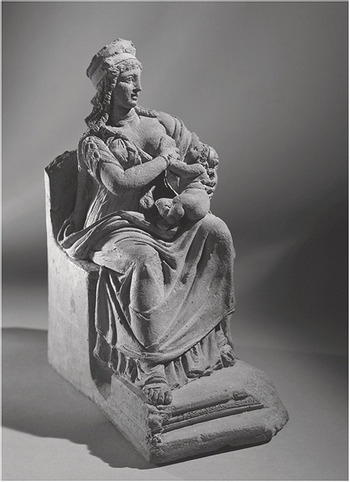 Isis the Mother
Isis the MotherIn my kindness, I provided man with a docile spouse [now we know this aretalogy was written by a man, ha!], binding both of them beneath the yoke of matrimony, while sweet Persuasion with its gentle breeze, lulled the treacherous steep gorge to sleep. I set up the pillar of pleasant law amongst the inhabitants of cities, giving it a likeness finer than gold… For us, from the dark…was born… Instead of….obtained wealth. The features of a pure…the curtains of the marriage bed embroidered with fabric like gold… who prepares marriages when young girls of the same age…. the torches with the hymenaea [nuptial hymns] as befit a lovely wedding … [This section shows Isis as a Hera-like promoter and protectress of marriage.]
I separated the…barbarian from the sound of the Greek voice [likely a reference to Isis creating different languages for the nations of humankind; other aretalogies mention this. The aretalogy of Maroneia notes that She and Hermes-Thoth devised different alphabets.] …to the mortals nature… …of contrasting shame… …I imbue the oath with dreadful terror … …swiftly the Erinys… …with her sting …with the frail ones … …offers (…) sweet as honey …wandering the ocean…I remained… …compassionate… …raising the storm… …the sea’s calm …excited ….Pontos [a primordial Sea God] in the abyss … the trace… [Again, the fragmentary nature makes it hard to understand, but all these powers of the Goddess are seen in other aretalogies: She created languages and writing. She made the oath powerful and backed up by the threat of the Erinys. She raises and calms storms at sea and She is compassionate.]
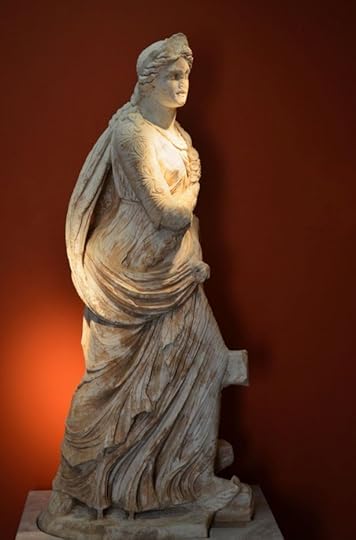 Isis Pelagia
Isis Pelagia…with my shining brother, I tend to Helios’ palace and they call me his consort [Isis can sometimes, though rarely, be the consort of Re; more often, She is His Fiery Eye, usually His daughter]. Sent through the celestial circles, I am borne upon His rays across the shining heaven. Whatsoever I set my mind to, I bring it all to fruition. At every gesture of my head, the mighty abase themselves before my power, fearing Our [the Royal “we”] supreme royalty. I untied fate from its bonds [in this period, Isis is often invoked as a Goddess Who could free one from their fate]. Amphitrite [a Greek Sea Goddess], fond of fair weather, advances across the water in Her black-prowed ship beneath the cold, unclean spray, when—a smile reddening My cheerful cheeks—I send forth baleful-armed Tethys [a Titaness Sea Goddess; sometimes assimilated with Isis]. In the navigable depths, when my desire stirs up my heart I hasten through the tortuous path to make it into a desert, and I sweep everything with a somber downpour. Pontos in his deep grottoes, silently bellows from the recesses of his sanctuary. The first, on the ship’s deck, I led the agile skiff with swelling sails, riding upon the stream while seas tamed by swift naves, Doris’ [consort of the Sea God Nereus and mother of the Neriads, a group of sea nymphs] glorious progeny emitted a whirling chorus. And My mind trembled with awe, eyes fixed on the yet unknown beating of oars. [So, here we have Isis as controller of the seas and the weather, and inventor of sea travel (“as-yet-unknown beating of oars”).]
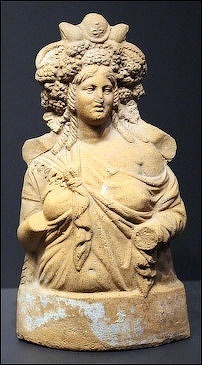 Isis of Abundance
Isis of AbundanceI, Isis, against the frigid cloud of wars with its woes, compassed the opulent kingdom with a circle of battlements. From the hollow of their roots, I uplifted islands from deep mire to light. Even mountains I brought forth, the foundation of fields fit for sowing, and the verdant meadow that I spread over firmly established heights, pleasing to cattle sheds and shepherds. Over the bubbling wave did Nereus strike with his trident the resounding flow, sparkling with foamy flowers, at the shores hurtling against the even rocks. From my dewy brow, I urge forth abundance for my native fruitful land, the ripening grape, dispenser of pleasure. Making thunder coruscate with boundless might, I roar it forth, a fierce threat to mortals. What fate’s distaff has spun, what Atropos [one of the Fate Goddesses] ever twirls with her hands in impetuous whirls, has obeyed me,…endlessly… …reed stalks… …in whirls. Rending clods asunder… …over the seas… …thick ash… the Nile’s…” [And in this final section, we see Isis as a protectress, shielding the “opulent kingdom” with battlements, as a Creator Goddess Who raised the islands and created the earth for humans and animals, and also as ruler of the sometimes-frightening powers of Nature. In addition, Isis rules Fate and Fate obeys Her, which was one of Her most important functions in the Greco-Roman period.]

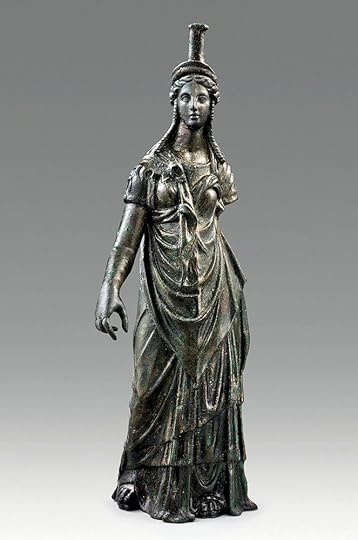 Isis Fortuna; love Her graceful posture
Isis Fortuna; love Her graceful postureIn addition to promoting a sense of community among Isis devotees throughout the Greco-Roman world, the Isis aretalogies “spread the gospel” of Isis. They helped to universalize the powers and nature of Isis so that people outside of Egypt could see Her as a Deity they, too, could love and call upon in their times of need. Although Isis always remained connected to Her native Egypt, through the aretalogies, She could easily be understood to extend Her powers to other lands, and other peoples, as well.
Just as, in Egypt, Isis was known as “The Only One” (Ta Uaet), and She expressed a full range of Divine powers as “Isis, Goddess in All Names” (Iset, Nutjeret em Renus Nebu), now this universalizing idea came with Her as She moved outside of Egypt, and She became—for so many people in the Mediterranean world—the Goddess of Ten Thousand Names.
October 19, 2025
A Prophetic Dream of Isis
As we continue finding the scattered bits of Isis lore, today I bring you a dream. Not my dream. An ancient dream. A dream of the king Nectanebos II—it is a dream of Isis, of course.
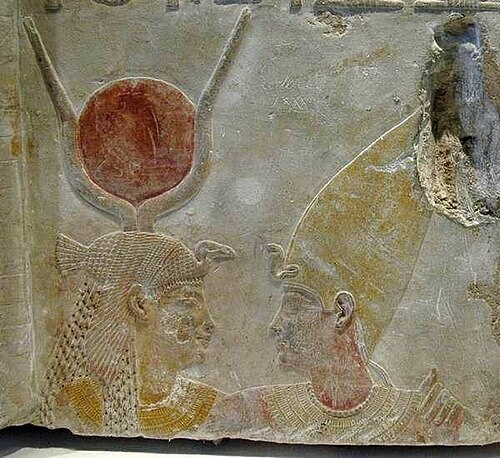 Nectanebo II with Isis
Nectanebo II with IsisBut first, a bit about Nectanebos himself.
There were two Nectanebos. The dreamer was Nectanebos II, and he was the last native ruler of Egypt, before Egypt fell to Persia (again). His Egyptian name was Nakht-hor-hebyt, meaning Victorious is Horus of Hebyt. He was the grandson of Nectanebis I (yes, there’s a slight difference in the Greek spelling of the names).
Persia had conquered Egypt in 525 BCE, but Egypt regained independence in 404 BCE. The intervening years featured alliances with Greeks to keep the Persians out, as well as both internal and external struggles. Nectanebos II repelled the Persians several times during his reign and became a hero to his people. But ultimately, his alliances with some Greek cities failed and he and his army were defeated, making Nectanebos the last native ruler of Egypt. With defeat, he fled to Upper Egypt and finally to Nubia, where he tried to reestablish power, but was unsuccessful.
 Isis receiving offerings from the king at Isiopolis
Isis receiving offerings from the king at IsiopolisThe dream that Nectanebos had is sometimes thought to have been a prophetic one, revealing Egypt’s eventual defeat by Persia.
Nectanebos was an Isis devotee and he contributed construction to Her temple at Philae and was the one who originally commissioned Isis’ temple at Isiopolis (Benbeit el-Hagar).
I’ve actually told the tale of Nectanebos’ dream before, since it has to do with Isiopolis. Here’s a link to that story. But I also want you to have translations of the actual texts in which we find this story, so you can see them for yourself.
A Greek version was found in the writings of Apollonios, who lived in seclusion in the Sarapeum of Memphis, Egypt. He only included the beginning of the story, however. We also have some bits of the tale in Demotic from a temple library.
Here’s Apollonios version, in which we find Our Lady Isis:
Year 16 in the night of Pharmouthi 21st to the 22nd , in the divine reckoning by the full moon, King Nectanebos was in Memphis and performed a sacrifice, asking the gods to reveal to him the impending future. In a dream he saw a boat made of papyrus – what they call rhops in Egyptian – come to anchor at Memphis. On it was a great throne, and upon that was seated Isis, glorious benefactress of crops, queen of gods, and all the gods in Egypt stood beside her to her right and left. One of them, called Onouris in Egyptian and Ares in Greek, and generally thought of as being thirty-one and a half feet tall, stepped forward, prostrated himself on his stomach, and said:
“Come to me, Goddess of Goddesses, mightiest in power, ruler of the universe, saviour of all the Gods, O Isis, be gracious and hear me. Just as you ordered, I have preserved the land perfectly, and while King Nectanebo has exercised every care for me up to the present, Samaus whom you installed in the priesthood has neglected my temple and has resisted my commands. I am thrust out of my own temple and everything in the inner shrine is half-finished on account of the villainy of the priest in charge.”
The Queen of the Gods heard the aforesaid but made no answer.
After seeing this prophetic dream he awoke and gave orders to send in haste to Sebennytos, to the high priest and priest of Onouris. When they appeared at his court the king asked them what work was unfinished in the inner shrine, the one called Pherso. They said that everything was finished except the inscribing of the hieroglyphs being carved on stone, and he ordered them to write with dispatch to the famous shrines throughout Egypt for hieroglyph carvers.
When these had arrived as ordered, the king asked who was the most skillful one among them, the one best able to complete the unfinished work in the inner shrine called Pherso. In response the one from Aphroditepolis in the Aphroditepolite nome, whose name was Peteēsios son of Ergeus, stepped forward and said that he could finish all the work in a few days. The king questioned the others as well, and they all stated that Peteēsios spoke the truth and that there was no one in all the land who could even pretend to be like him. Accordingly, the king assigned the aforementioned work to him at a lavish rate of pay, at the same time urging him by reason of the god’s will to pursue the task to completion in a few days, as he had undertaken to do.
Peteēsios took the big bundle of cash and departed for Sebennytos, where he decided, being a souse by nature, to take a holiday before tackling the job. And as he was walking about in the southern part of the temple he happened to notice the daughter of a perfume maker, who was the most beautiful girl he had ever come across in that . . .
Here are the small bits from the temple library at Tebtunis:
It happened in year 18 of the reign [of king Nectanebos, who was a beneficent king of the entire land,] Egypt being [united with all good things in his time] . . . He saw [himself in a dream . . . upon . . . A great god went [into the middle] . . . strangled (?) by him . . . time . . . Egypt . . . Nectanebos . . . [He] awoke [from the dream, these being the things that he had seen] . . .
And this one:
It happened in the 16th regnal year of the reign of king Nectanebos II, who was a beneficent king in the entire land, and [in] whose reign Egypt was overflowing with [all] good things. It happened one day that pharaoh said: “I am sad because of the terrible things that have happened to Petesis, son of Hergeus, the skilled sculptor of Aphroditopolis, in the temple of Sebennytos. [I] have given orders [to] find out the length of the time in which the said things will take place. I have given orders to find out the might of the foreigners that will come after me. I have given orders to find out the need which they will cause while they dwell in Egypt. May my preparation be made according to the journey which I to Wenkhem, that I might make my burnt offerings and my offering gifts between Letopolis and Phersôs {Per-Shu}.”
The preparation of the fleet of pharaoh was made. Pharaoh went on board the fleet. He did not delay to go to Wenkhem. He went to the temple [of Wenkhem] between Letopolis and Phersôs. He presented burnt offering and libation before Haroeris . . .
 Golden Isis by Jane Marin. Jane no longer has this art on her site, but see other work here.
Golden Isis by Jane Marin. Jane no longer has this art on her site, but see other work here.
October 12, 2025
Isis Soteira; Isis as Eternal Savior
One of Isis’ epithets in the Hellenistic world was Soteira, “Savior,” or more precisely, “Savioress.”
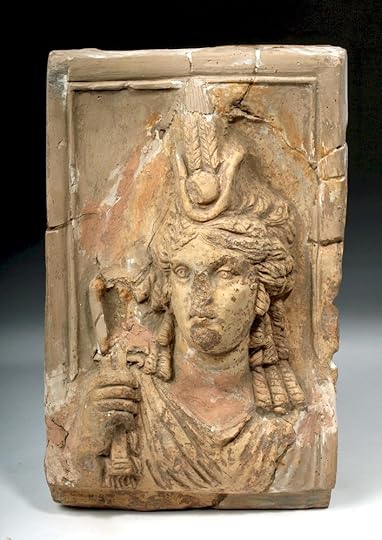 A Greco-Roman image of Isis
A Greco-Roman image of IsisIf the Christian* Deity, Jesus, is the only one with that title you’re familiar with, that epithet might feel a little weird. For some of us, it might even feel deeply uncomfortable.
So, let’s look at that.
Those of us living in a largely Christian nation are probably most familiar with the Christian concept of salvation. As a result of Jesus’ sacrifice on the cross, believing Christians can be “saved,” “forgiven,” or “redeemed” of their sins—from the “original sin” one inherits by simply being human, to the major and minor errors all human beings inevitably make. As a saved soul, after death they reside in heaven, among the angels and the good.
But many Christians also have a more worldly notion of being saved. One might consider that Jesus saved them from alcoholism. Another person might believe that Jesus saved them from being hit by a car when they accidentally walked into traffic. Some might even praise Jesus when their team wins a football game, saving them from losing, I guess.
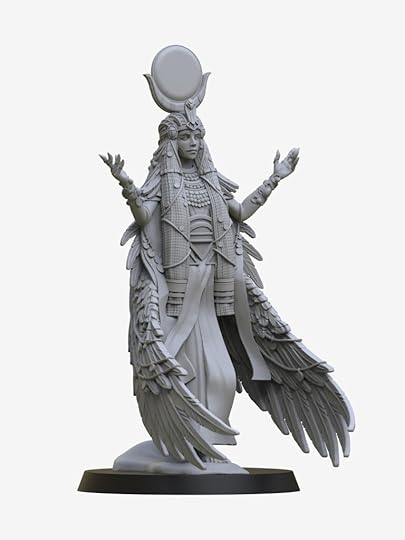 An interesting 3D model of Isis that came up when I searched “Isis the Savior.” See more of the work here.
An interesting 3D model of Isis that came up when I searched “Isis the Savior.” See more of the work here.And that’s all very human.
Prior to the formation of Christianity, this worldly type of saving was one of the ways many Pagans in the Mediterranean world viewed salvation as well. I’m skim-reading a book now about ancient Greek concepts of salvation and the many Savior Deities they worshipped—Isis among Them, of course.
We find ancient people setting up votive offerings in temples of Soteira (fem.) and Soter (masc.) Deities throughout the Hellenistic world. In Greek, soteria can mean “saving,” “preservation,” “safety,” “deliverance,” “rescue,” and similar concepts.
Votive stelae attest to people being saved from earthquakes or lightning strikes. People made offering to Deities Who cured illness. The aretalogy of Isis from Maroneia was a thank-offering given to Isis for curing a devotee’s blindness. Those who lived and worked along the shores of the Mediterranean set up stelae to the Deity Who helped them reach safe harbor after a voyage at sea. Isis Pelagia is prominent among these sea-saving Deities.
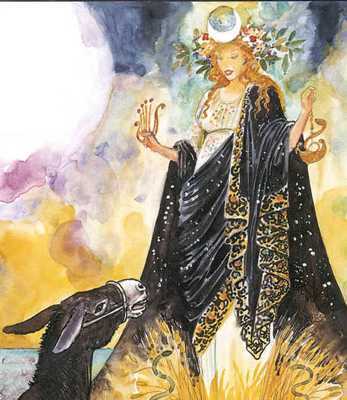 Isis appears to Lucius, pre-salvation
Isis appears to Lucius, pre-salvationBut, the ancients also understood the idea of “reaching safe harbor” metaphorically. A funerary inscription of a priest of Isis noted that, due to his service to the Goddess, he would not travel to “dark Acheron”** when he died, but would instead arrive at “the harbor of the blessed.”
Reaching such safe harbor was one of the many reasons people sought initiation into the Mystery religions of the time. People knew that Mystery initiations could bring them worldly salvation—such as a fresh start, a deeper understanding and experience of the Mystery Deities, or healing. But importantly, initiation into the Mysteries could also bring salvation in the Otherworld and lessen our natural, human fear of death.
In Apuleius’ tale of the initiation of his character, Lucius, into the Mysteries of Isis, the Goddess first saves Lucius from having been magically transformed into an ass. Then She promises that he will live his life as a happy man, and when he dies, he will pass into the Otherworld, continue to worship Her, and will dwell in the Elysian fields (roughly, “heaven”).
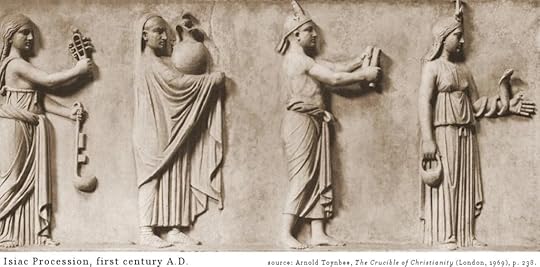
Initiates of the Mysteries of Isis also gained rebirth and spiritual regeneration while still living. Growing out of the ancient Egyptian funerary tradition of rebirth after death and merged into the Greco-Egyptian religiosophic mix of Hellenistic Egypt, the idea of spiritual regeneration became a popular notion among the votaries of Isis in the late-Pagan period. For as Lucius says, “She [Isis] caused them [Her initiates] in some way to be born again and placed them once again on the course of a new life.”
And no matter how much some folks might like to separate Greco-Roman Isis from Egyptian Isis, there is deep continuity in Her core nature; none of this “saving” was new to the character of Our Goddess.
 As She saved and renewed Osiris, so She saves all of us
As She saved and renewed Osiris, so She saves all of usIn the Egyptian Faiyum, where the Greco-Egyptian Isidorus composed his hymns to Isis in Greek, he names the Goddess as “Deathless Savior” in the early 1st century BCE.
Elsewhere in Egypt, and long before Isidorus’ time, Isis is among the many Egyptian Deities Who were perpetually concerned with regeneration, renewal, and—ideally—a reset to the perfection of First Creation, the Zep Tepi. Indeed some scholars consider all ancient Egyptian rites to be focused on these concerns.
As a Primordial Goddess, Isis was there at that perfect beginning. Isis is called “She Who was First,” an epithet found not only in Isis’ own temples, but also in the temples of other Deities. At Dendera, for instance, we learn that “all things come into being after Her” and “all things begin with Her.” Isis is a Goddess Who creates and Who then preserves what She has created through Her powerful, renewing magic. Other texts at Dendera tell us that She is the one “Who begins all good/beautiful/perfect [nofer, in Egyptian] things.” At Her Isiopolis temple in the Egyptian Delta, it is “She Who lets goodness/beauty/perfection emerge” and “She Who creates the beneficent things.”
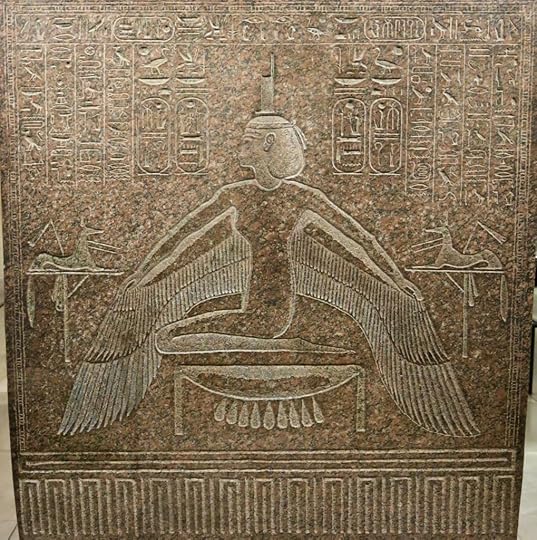 Isis spreads Her protective wings
Isis spreads Her protective wingsBecause She created beneficent things, bestowing Her beneficence to all, She is known as the one “Who hears the petitions of millions.” A graffito from Thebes advises, “O you of all lands! Call to Isis, the Great Goddess! She listens at every moment, She does never abandon the one who invokes Her in the road [that is, while traveling].” People also call out to the Goddess when they are afraid, for Isis is “She Who rescues from fright/misfortune” and “She Who saves the weak from the violent.” And, as I’m sure you already know, many invoked Her then, and many still do, to save them from illness and to promote healing of all kinds.
Isis’ beneficence extends into the funerary realm as well. She is the Queen of the Netherworld and is “at the head of the Mysterious/Secret Netherworld [“at the head” means She is the chief of that realm].” At Her small temple of Deir el-Shelwit, Isis is “She Who commands those who are in the necropolis.” And, of course, Isis is the one Who raises Osiris from the dead to become Lord of the Otherworld. When Osiris sees Isis there, welcoming Him into the land of the dead, He rejoices. In our own afterlife journeys, we, too, can rejoice when we see Her for “true is Isis, Who acted on my behalf.” We can know that She will spread Her protective wings over us as we are reborn into our new life among the Aakhu, the “Akh spirits” who are the transfigured and blessed dead. We are all under the beneficent wings of Isis, the Lady of the Otherworld, the Lady of Silence.
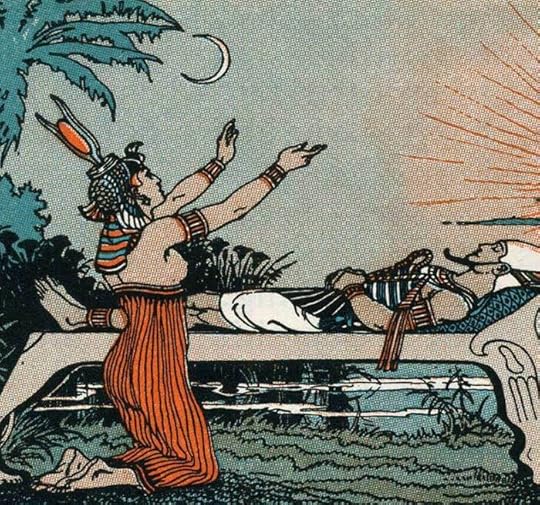 Isis works Her magic to raise Osiris
Isis works Her magic to raise OsirisAs part of Her Divine Mystery, Isis is a Goddess of Eternity. Isis is “She Who engenders eternity” and “She Who brings into being everlastingness.” (For more on these two important types of ancient Egyptian eternity, see my posts here and here.)
Whether within the borders of Her homeland of Egypt, or outside of it, as Her worship spread first throughout the Mediterranean world, and then throughout the Roman Empire, Isis has always, always been a saving Goddess, a Savior Goddess, even though that specific term was not used until later.
As Isis devotees, we know that we can call on Her for help in the trials of our daily lives. We know that we can ask Her to hear us, and to help protect us, and to help heal us. And when our own lifespan is over, and we enter the Great Mystery to discover for ourselves what lies beyond, I, for one, know that I will rejoice when I see Her there, shining like holy starlight in the Otherworld, leading me on—my Soteira, my Lady of Eternity and Everlastingness, my Tana, my Isis.
How about you? Have you ever been “saved” by Isis? I’d love to hear your story.
*And some Jewish sects, such as Messianic Jews.
**One of five underworld rivers by which one crossed over to the land of the dead, thus an entrance to the land of the dead; sometimes used more broadly to refer to the entirely of the land of the dead.
October 5, 2025
Isis, the One & the Many More
Part 2
 And now we know how a black hole sings
And now we know how a black hole singsPortland. Still not “war-ravaged.” Still peaceful. Still snarky. Still resisting.
And now, back to our topic.
Last time we looked at several of the many ways human beings have envisioned the Divine Reality and how each may be of value in our always-developing relationship with Isis.
As we start today, let’s also keep in mind that people will always have issues with the way just about any of these theisms is defined as well as who should be defined into or out of any given group. As we said last time, one’s conception of Divine Reality remains a touchy subject; it should be approached with kindness and curiosity.
It is not my intent to propose any all-inclusive definitions, nor to sort anyone into any box, whether that box is hard-edged or more flexible. In fact, it may be just the opposite. I hope we can explore our relationship/s with Isis through a wide variety of theistic lenses. Each of them may have something to teach us about how humans have imagined the Divine Reality and, as we try them on, we can decide for ourselves which ones are the best fit—or the best fit right now.
 Isis as Creatrix by Jeszika Le Vye; you can buy a copy at the link
Isis as Creatrix by Jeszika Le Vye; you can buy a copy at the linkIsis & Polytheism
First up today, polytheism. Easy, right? A belief in many Deities. But in recent years—less so now (I think) than five or so years ago—modern polytheists have been discussing types of polytheism, which are usually referred to as hard or soft polytheism.
“Hard” and “soft” polytheism?
In simplest terms, hard polytheism refers to the concept that many Deities, Who are separate and real Beings, and Who have their own agency (that is, the ability to take action as They desire), exist.
Soft polytheism’s definition is, as you might expect, a bit more complicated and can be an umbrella for a number of different ways of looking at the Divine Reality. One of those ways is that the world’s Deities are all expressions of one Deity or a core pantheon of Deities. Dion Fortune’s famous axiom: “All the Gods are One God, all the Goddesses are One Goddess, and there is One Initiator” is an example of this concept. Or we might consider that the Deities are personifications of natural forces (sun and moon, for example). Or that the Deities are psychological or archetypal (for example, Jungian archetypes). Some modern Pagans distinguish this last type of polytheism as naturalistic and eschew any kind of metaphysics in their view.
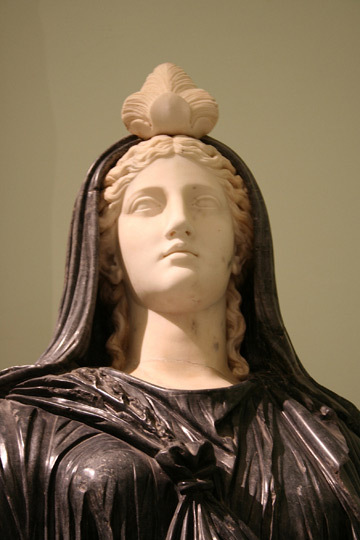 Roman Isis, from the 2nd century CE, in the Farnese Collection in Naples
Roman Isis, from the 2nd century CE, in the Farnese Collection in NaplesAll of these expressions of polytheism are relatively easy to use as a framework for at least a part of our relationship with Isis. As a unique Divine Being with Her own agency, personality, and concerns, we can make offerings to Isis of Her favorite things. We can pray for help with Her traditional concerns. We can meditate on Her many powers as they have come down to us from ancient myth and historical research. As She is the Goddess of Magic, we can work magic with Her help. It’s likely that this is the way many of us connect with Her on a day-to-day basis, whether or not we conceive of Her as a discrete Goddess or as part of an underlying unity.
If we take a “soft” perspective, we might see Isis as many of Her ancient worshipers did, as the Goddess of Ten Thousand Names, She Who is Isis and Neith and Aphrodite and Hera and Hekate and so many more. Or, if She is a personification of a natural force, which one? Heka? Sun? Sirius? Wind? (She’s such an all-encompassing Goddess, it’s difficult to choose just one; but, of course, we don’t have to.) If we consider that She is all of them, what does that tell us about Her Nature and Being? Or, if She’s an archetype, which one or ones? Mother? Magician? Trickster? Healer? Ruler?
 Statue of Isis from the Greek sanctuary at Brexiza, about 160 CE
Statue of Isis from the Greek sanctuary at Brexiza, about 160 CEYet this far from concludes our polytheistic options.
Henotheism, kathenotheism, monalatry & Isis
A henotheistic conception of the Divine holds that while there are many Deities, we focus on one without rejecting the others. It was first coined in the 1700s and originally used to describe the so-called “primitive monotheism” of the ancient Greeks. A number of modern scholars use it for the syncretism of Late Antiquity in the Mediterranean—with the worship of Isis being the prime example.
Henotheism may also include the idea that all Deities are united through one Divine Essence; this approach is thus related to a kind of monism, which is why some scholars prefer the term monalatrism to henotheism. Another type of henotheism is kathenotheism, in which one worships “one God at a time.” This may be my own most common personal practice. While I am devoted to Isis and to Dionysos, and I have some kind of a…thing…with Raphael, I don’t work with all of Them together, but rather one at a time.
It has been my experience that many modern Isiacs relate to Isis through some form of henotheism, at least sometimes. Employing this view, we learn that we can have a primary Deity or Deities without rejecting other Divine Ones. It allows us to be good guests in the temples of Deities Who are not our primaries, yet we still know Them as the true Divinities They are.
Isis & Pantheism/Panentheism
Pantheism is the idea that unified Divinity is completely immanent in the created universe. All-That-Is is God/dess. Generally, pantheists don’t posit a personal Divinity, though they attribute Divine qualities, such as eternity and ineffability, to the All-That-Is. There is quite a bit of philosophical/theological discussion about what-all this means. (I refer you to the Stanford Encyclopedia of Philosophy for that.)
But I’m trying to simplify. Pantheism might be another case where we could say, “Isis is All Things and All Things are Isis.” In this case, everything is not just OF Her (as Source), but IS Her. How would we relate to our world if we could keep that conception in the front of our minds? How does the act of making offering—or any ritual for that matter—change? Does Deep Mystery become Deep Science?
 Her blood the Waters, Her body the Earth, art by Cristina McAllister; you can buy a copy at the link
Her blood the Waters, Her body the Earth, art by Cristina McAllister; you can buy a copy at the linkPanentheism takes this a step further. Divinity is immanent in the universe, but It also extends beyond both time and space and is transcendent in relation to the universe. Like pantheism, panentheism is a relatively new word, being coined in 1828. Neoplatonism, some Hindu sects, some South and North American indigenous religions, as well as some sects of Judaism and Kabbalah, Islam, and Christianity have some panentheistic elements.
We can also point to such elements in post-Amarna Egyptian theology. One of the hymns to Amun-Re hails Him as “the one Who makes Himself into millions, Whose length and breadth are limitless.” Egyptologist Erik Hornung, in discussing this hymn, understands “oneness” as the condition of the God before Creation and “millions” as the polytheistic Divine Reality after Creation. Egyptologist Jan Assmann (mentioned in relation to his “Mosaic distinction” last week) explains that Amun-Re, as the One Who makes Himself into millions and yet remains within, behind, and encircling the multiplicity He has created, gives us a panentheistic Deity Who is within the Creation, but also prior to and containing it.
We have already met Isis in an All-Goddess capacity in some of our monotheistic and monistic discussions. And while I’m sure philosophers and theologians can discuss the complexities and distinctions, again, I am trying to simplify. What both of these views may do is bring Isis closer to our world. It is easy to see Her in the natural world as river or mountain (“Her blood is the water, Her body the earth”), but is She also [in?] the laptop I’m typing on? For me, there is an intimacy in this conception that feels personal, whether pantheistically, we reject the idea of a personal Deity, or panentheistically, we (sort of) accept it.
Animism & Isis
Some philosophers and theologians see the beginnings of pantheism in animism. Animism is an ancient worldview in which all things, from Deities to humans to plants, animals, and rocks, all have their own spiritual essence/soul/spirit. Everything is alive in some way; everything is spiritual. Generally, these essences are distinct—so we can interact with the plant people or an individual tree for example. There may or may not be an underlying unity. There is ongoing discussion as to whether animism is a religion or a worldview.
Personally, I’m trying to bring animism to the top of my mind more often.
 Ka statue of King Hor with the ka symbol on his headdress
Ka statue of King Hor with the ka symbol on his headdressIt is easy to see animist harmonies with the ancient Egyptian concept of the ka, the vital essence in all things (and to some extent, the ba; but let’s just stay with ka for now). Ka is the difference between life and death. It can be given, transferred, and received. We can interact with it in the beings around us. It connects us to our ancestors and even back to original Creation, the Zep Tepi or First Occasion. While each being and thing has its own ka, there is an underlying relationship between all kas due to their origin in First Creation, so here we have an underlying connection if not unity between all things.
In this view, Isis has a Divine ka—or many kas since She is a tremendously powerful Deity. We may seek to learn about and to experience Her ka in meditation. When making offering, it is the ka of the offering that is transferred to the ka of Isis in order to receive its nourishment or other benefits.
I have been working on becoming more conscious of the ka in all things as I move through my life. It definitely takes practice, what with all of life’s mundanities, but it is also a fulfilling way to re-enchant the world.
Autotheism & Isis
The last type of theism I’ll address is autotheism. It’s a new term to me, but it’s an old concept, and one that fits quite well with ancient Egypt. The Wikipedia definition is fairly straightforward: “the viewpoint that divinity, whether also external or not, is inherently within oneself and that one has the ability to become godlike.” (You’ll also see it defined as the worship of oneself, but that’s not what we’re talking about here.)
 The fiery heart of the divine within
The fiery heart of the divine withinIn the early days of my involvement in the local Pagan community, part of the Circle was often to greet each other with “Thou art Goddess.” It drove me slightly crazy because it seemed like a treacly platitude. But I was wrong. This autotheistic concept is what was intended: recognizing that there is Divinity in me and in you and in all of us. In Isis Magic I have called this Divine Within the Isis Heart—the Iset Ib—which is our deep and Divine connection to Her.
I’m going to leave aside the question of whether or not humans can become godlike while alive (in some circumstances, yes; but it bears more discussion than we can do here). Instead, let’s head back to ancient Egypt and Isis.
As many of you already know, the pharaoh was considered a living Deity—at least when acting in specific capacities. Pharaoh was also deified in death. For most other Egyptians (at least the ones for whom we have records), becoming godlike was an after-death experience. With proper rites and having lived a life of ma’et, one could become an akh, an effective or transfigured spirit. Akhs could be effective on earth; the famous “letters to the dead” were likely addressed to the person as akh. And, being a godlike akh, they could dwell among the Deities in the otherworld.
The spiritual Work of discovering and nurturing our own divine natures is growth ably guided by the hand of Isis. As we develop our relationship with Isis, we will also deepen our human nature and discover our divine nature. It is easy to understand being the best human being we can be, but what does it mean to help our divine nature blossom? How is that different from our best human nature? Or is it?
Harmonies and paradoxes
 Looking into Her heart
Looking into Her heartThinking through the different views of Divine Reality humans have envisioned is a worthy meditation for today’s devotees of Isis. For if we look back to the traditions of ancient Isiacism to instruct or inspire our modern devotion at all, then we will inevitably find ourselves confronted with holy puzzles that might slot into one or another of these various ways of looking at Our Goddess and the Divine Reality.
As we meditate on these puzzles, we may come to discover our own answers…at least our answers for now. Personal answers to questions like these can change over time as we discover, experience, and learn more about ourselves and about our relationship with Her.
September 28, 2025
Bodies, Sexuality, Strength, and Badass Sorcery—Again
Well. Here we are again.
Portland is once again being invaded by “troops and federal agents” to put down our pretty damn peaceful “war-ravaged” city.
So instead of Part 2 of our discussion of ways to look at the Divine Reality, I’d like to repost the first part of something from 2020, written during the George Floyd protests here. It still applies.
Just to be clear, Naked Athena is from 2020, not now. But who knows? Maybe she will rise once more.

I rarely post anything political on this blog. That’s not what it’s for. But sometimes—like when your city has been invaded by goon squads kidnapping citizens—it’s hard to write about anything else. And so, for a lead-in to today’s post about ancient Egyptian sexuality and Isis (here is the full original post), I am proud to introduce you to “Naked Athena.”
THIS. This is why I love this city. This is the power of a vulnerable, naked human body. This is the power of Art.
 Portland protestor calls out police in a stunning display of what one Twitter poster called “badass sorcery.” Damn right, it was. In confusion, the cops actually backed off after this.
Portland protestor calls out police in a stunning display of what one Twitter poster called “badass sorcery.” Damn right, it was. In confusion, the cops actually backed off after this.Now, here’s another photo of the same kind of vulnerable power:
 This is Ieshia Evans. Learn more about Evans and that protest here. (Photo info: A demonstrator protesting the shooting death of Alton Sterling is detained by law enforcement near the headquarters of the Baton Rouge Police Department in Baton Rouge, Louisiana, U.S. July 9, 2016. REUTERS/Jonathan Bachman)
This is Ieshia Evans. Learn more about Evans and that protest here. (Photo info: A demonstrator protesting the shooting death of Alton Sterling is detained by law enforcement near the headquarters of the Baton Rouge Police Department in Baton Rouge, Louisiana, U.S. July 9, 2016. REUTERS/Jonathan Bachman)What is the difference between the stories of these two photos taken four years apart? Naked Athena was not arrested for her protest (nudity is officially illegal in Portland, but court rulings have made exceptions for protests). Ieshia Evans was. It is blatantly obvious that there’s a lot of justice work to be done, folks. Ma’et calls us to it and Black Lives Matter.
Deep breath.



